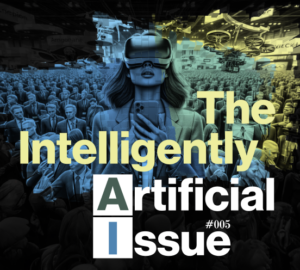The
prompt interface
needs a
redesign
No, it doesn't
We need “smarter” humans, not design
Everybody hates chatbots. And yet, the fastest growing consumer-facing technology in human history is basically a chatbot. Is there a problem here? Is this a good moment for a design intervention?
Let me start with a fundamental question: why do people hate chatbots? Is it the design, or the experience?
Historically, conventional customer service chatbots were insanely annoying and, critically for users, fundamentally dumb. They locked users in a recursive loop of unanswerable questions that yielded no results; the only escape from this torture was to force a connection with a human.
In this moment, the human represents context and the ability to reason, while the bot represents a brick wall. So let me answer the first question: the reason people hate chatbots is the experience. The design is fine.
What happens when the conventional chatbot interface is replaced by a different backend technology? Generative AI is doing this right now by breathing artificial cognition into the brick wall, giving it the ability to convert context into reason, turning the whole interface on its head. No more need for any human intervention.
Layering generative AI into chatbots introduces two problems that a redesign cannot solve.
The first problem: humans are biased against chatbots.
They see the interface and automatically expect a conventionally dumb experience. This also happens when you see a website with a web 1.0 design. As a result, they enter into the experience with a lower level of engagement that affects the quality of their prompts. As the saying goes: garbage in, garbage out.
This article is part of The Intelligently Artificial Issue, which combines two big stories in consumer tech: AI and CES.
Read more from the issue:
USER EXPERIENCE
Augmented Intelligence: from UX to HX
Will prompting replace browsing?
The car is the gateway drug to a voice-first acceleration
The prompt interface needs a redesign
RE-ORG
AI will brainstorm your next reorg
Expect fewer managers and direct-reports
AI is too immature for your business
AI is not a new revolution
BRAND
Should we ignore the hardware?
Can AI help consumers love your brand?
Your brand doesn't have enough data for AI
Can LLMs be optimized like search results?
Good brands will integrate more friction into their C X
The second problem: humans are mostly lazy.
They imagine that a generative chatbot is going to magically read their mind and solve humanistic conscientious tasks with minimal effort. This perspective influences the quality of their prompts and the scrutiny they give to the responses. This looks a little different than the first bias: generic prompts generate generic responses that are accepted without a second thought because most don’t realize how much better the output can be.
I have seen user testing experiments that confirm the second problem. Two user groups were asked to brainstorm creative ideas for an imaginary product. One group was given an AI chatbot while the other was given paper and pencils. The AI group produced the least interesting ideas and devoted the least amount of thinking to the assignment (until they were taught how to work optimally with the chatbot).
So let me sum up my argument: The AI chatbot interface does not need a redesign. It needs humans to catch up to its capacity. This involves something bigger than UX design.
Humans need to become better at conversation. This is going to take time, but it won’t be the first time.
I have been working on the internet since the 1990s. I spent time demonstrating internet browsers to executives who were still asking their assistants to print out webpages for them to read. Those executives were uncomfortable by the technology and simply needed more time to evolve. Going back further in the technology timeline, the keyboard and mouse triggered the same response. Sometimes, the design is not the problem and humans just need time to adapt.
Yes, it does
Design can make chat a better experience
It is hard for me to disagree with an argument that is so well-structured. But Henrik, this is ON_Discourse and we have to live by our creed. I think your approach to this topic is overlooking the impact of design and where we are in the adoption curve of AI semantic prompt-interfaces like chatbots we see in ChatGPT or text bars like we see in Google Search.
Before we get there, let me start by recognizing your strongest point:
The mouse and keyboard are an excellent analogy for generative AI chatbots. The analogy works because it acknowledges the transformational context that follows these interfaces. To put it bluntly, there was no precedent for either the mouse or generative AI at the release of either of those products. In both cases, it is natural to accept an elongated adoption curve. Sometimes, the burden just falls on people to figure it out.
But I am concerned by the focus of your argument. At the end of the day, the novelty of this tech does not relinquish the role and value of good design. Do you remember the AOL portal? For a limited time in the 1990’s, this was the predominant way most Americans accessed the internet. It had a design language so ubiquitous that it nearly defined the early-internet. Then new designs and platforms emerged for new behaviors that slowly disintegrated this design system.
When I think about the evolution of semantic chat experiences in the AI era, I see the same massive opportunity that you see, but I think of it in a different way. I’ll break it down in a few ways:
Good interface design focuses on behaviors.
The interfaces that win online are those that more accurately deliver an existing behavior in a better way. Tik-Tok pioneered a new interface for video creation and consumption without instruction manuals. Not only did this interface drive historic audience growth, it also fed an explosion of new UI paradigms for non-content experiences (from news feeds to credit card applications). Good design can accelerate the learning curve without being explicit.
At the end of the day, the novelty of this tech does not relinquish the role and value of good design.
The prompt-era is just beginning.
The use-cases for this interface are still in the proverbial laboratory. This is not the same context of the keyboard or mouse which was one of the essential catalysts of the personal computer revolution. It unlocked new ways of thinking about screen design, leading to the GUI, which ultimately brings us to our own digital discourse. AI is different. It is already propagating in the back-end operations of forward-facing companies. They are using this technology to drive internal creative sessions, augment audience research, and develop deeper customer profiles.
The jury is still out on the prompt.
I have no doubt that the prompt will become an essential interface on the internet, but I question whether it will become the dominant interface. The internet has evolved a number of optimized user experiences that are not served by an open-ended prompt experience. Let me put it this way; I’m not convinced that we are solving consumer problems by replacing context clues on a page with an open-ended prompt experience. In this vein, the customer is burdened with prompting in the right way to get the desired outcomes. I don’t feel like that is an improvement to what we have now (though I understand the impulse to consider it).
The technology behind the prompt is undoubtedly amazing and transformational. I agree that it promises to elevate our collective ability to use conversation to better understand our own needs and to find the information we need. Nevertheless, we shouldn’t assume the current interaction models are the future models. Additionally, when we ultimately deliver this tech, as with everything else that goes in front of consumers, it deserves a thoughtful, considered design.


